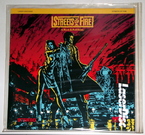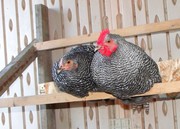An Experiment In Photo-Blogging
This album is a test to see if I can blog on 23 as it is, today. All blog entry "photos" would go here.

THE ERA OF LASERDISCS
After getting my first "big job" in the project management field, it wasn't too long before I had some extra spending money in my bank account. Along that time, which was the early 90s, I discovered movies on LaserDiscs. At the time, they were the best form of home movie entertainment technology. I spent the next decade building up a nice library of movies on LaserDiscs.
One thing that I soon discovered was these vinyl slip covers to help protect my discs. However, I could only find them via mail order, from a company far away in California.
I've since collected a few more LaserDiscs over the years since they stopped producing them, but I could never find these vinyl slip covers ever again. I guess I should have stocked up on more of them when I could. They're really nice, heavy vinyl, with a zip lock and the LaserDisc logo printed in white on the corner.

OLD POLAROID PHOTO FROM 1981
This photo was specially scanned and uploaded for Sonja!
This is a Polaroid from my 13th birthday, back in 1981. Although the image has taken on a yellowish tinge and faded a bit over the years, it's still quite clear as to what the photo is about. So, it is possible for Polaroid photos to last more than 36 years. (Wow, has it really been that long?!)
I'm in the center of the photo, with my younger brother and sister to my right, my mother behind me, and my neighbor friend to my left. My dad is taking the photo.

NEW FOTODIOX TLR FILM CAMERA KIT
Just finished building my own TLR 35mm film camera, a Fotodiox TLR. This was a Christmas gift from my wife, which I finally got around to building today.
It took me about two hours to complete. Now that I've done it, I could probably do it again in half the time. It wasn't that it was difficult to build, but there was a bit of a language barrier with the instructions.
The most difficult part was assembling the shutter, but it wasn't the simplest process to try and describe in written instructions. So, it took a bit of reverse engineering for me to figure out how the mechanism was supposed to work. Once I did that, it was easy to put together.
I have to say, for a plastic camera kit, it actually feels quite solid and well built. Now, I just need to get out and shoot some photos!

STUDY SHOWS CHICKEN'S INTELLIGENCE TO BE QUITE COMPLEX
I'm going into my third year raising chickens, and I can say, without a doubt, that these remarkable animals are more intelligent than we are typically lead to believe. I spend a lot of time with my flock and it amazed me to witness the unique personalities and mannerisms each of my birds possessed. So, it was not a surprise to me to read this study and it's conclusions.
I will not regurgitate all of the interesting information in the study, but I will sum up, in my own words, the concluding findings of the study.
1. The intelligence of chickens is on par with many other birds and mammals in the animal kingdom. In other words, they are not stupid, as many people believe.
2. Chickens do understand numbers and can do simple arithmetic.
3. Chickens exhibit self-control and self-assessment, which are attributes of being self-aware.
4. Chickens communicate in complex ways, and could be at the level of other highly intelligent and social mammals, including prime-apes.
5. Chickens have the capacity to reason and make logical inferences. This level of intelligence is typically developed by humans by the age of seven years.
6. Chickens perceive time intervals and may be able to anticipate future events.
7. Chickens are behaviorally sophisticated, and can learn skills from each other, similar to the way humans learn from one another.
8. Chickens have feelings, both positive and negative, including empathy, which is shared by humans and other complex animals.
9. Chickens have distinct personalities.
There is a lot of interesting information in this study and I encourage you to read it for yourself. But, what does this all mean? Well, to me, it means that we have totally underestimated the intelligence and awareness of chickens. If you feel that it is cruel to keep dolphins and whales in captivity, to keep dogs and cats in confined kennels and raised in puppy or kitten mills, then the cruelty done to chickens that are born and raised in a "battery farm" is unfathomable to these poor, mis-understood animals.
Thankfully the Lord has opened my eyes to the wonderment of His creation, and that there's more to these animals than just what they can bring to the dinner plate.

TESTING A WAY TO BLOG ON 23
I'm trying to see if I could actually use the existing 23 format to blog. The thought is to post a "blog" photo, like this one, to the account and use the description text to contain the text of the blog. It appears as though the photo description is pretty much unlimited, in length. I suppose, for search purposes, I would need to be thorough with my "tags", in order for the blog entry to be "searchable". To keep the blog photos separated from the regular photos, I could put them into a blog album, easily keeping them in one place. Now, if I wanted to add a photo to this blog entry, could I do it in the description field here?
It looks as though it is possible to post photos into the description field. Also, some basic HTML can be used, along with photo embedding techniques.
Although this is not the ideal solution, as these blog photos would clutter the Latest Activity section somewhat, it is at least something that I could do until 23 re-activates (or redesigns) the Stories module.

HOW SAFE ARE YOUR MEMORIES?
As I've been experimenting and playing with the new Lomo'instant camera, I got to thinking about what it was like to take photographs before digital technology. Digital photography has made it simpler to take nice looking photographs, as well as given us the ability to enjoy them instantly. But, it's also set the stage for a potential disaster, if you are someone who cherishes your photos and memories.
The convenience of digital photography certainly has pushed film photography to "niche" status. But this convenience has also made us dependent on the technology - dangerously dependent, if we're not careful.
One of the advantages that film photography has over digital is the ability to look at and enjoy your photos any time you want, whether you have electricity or not, whether it be today, tomorrow, or fifty years from now. As long as you keep your photographs in relatively good condition, you'll have them to enjoy for many generations. You are not reliant on anything further to ensure instant access to your photos and cherished memories. This isn't the same for your digital photographs.
With digital photos, you are completely reliant on your laptop, desktop, tablet, smartphone, or other digital device to read and display the digital files that are your photographs. If, for some unexpected reason, the storage device on which your photos are stored fails, or becomes obsolete and cannot be recognized by said device, you might as well consider your photos as gone.
Just think about it for a moment. As time goes on, each and every form of electronic storage will (or has) become obsolete. Are you old enough to remember having files stored on floppy disks? If you ever came across those floppy disks again, would you be able to look at those files today? How about ZipDisks? Sure CDs and DVDs are used today, but for how long; and do you still have a device that reads them? Today's tablets, Chromebooks and smartphones don't usually come with optical disc drives. There's probably going to be a time when these optical drives won't even be offered on laptop or desktop PCs. So, you better keep your older PCs in good working order, if you want to be able to look at your library of photo CDs in the future.
Services, like 23HQ, are a great way to ensure you have backups of your digital pictures, stored "off site". But, services like these depend on having access to the Internet, and outages do happen. So, completely relying on them to safeguard your memories isn't the best solution.
So, how can someone safeguard cherished photographs, giving them the best chance of being around to enjoy fifty years from now? The only way that I can think of doing this is doing what our parents, grand parents and great-grand parents did before us: have paper prints stored away in a photo album for safe keeping. I know, in this digital age, printing photos isn't something that many of us think of doing. But, it really is the only way I can think of to safeguard memories from obsolescence or from being erased.
These days, printing your photographs isn't all that expensive. Photo labs, at least around where I live, charge between thirty and forty cents a print. I print our photos with the Canon Selphy, which I purchased a couple years ago. The cost of printing my own photos is about forty-one cents a print (not considering the cost of the Selphy). This is quite reasonable, especially when you consider the cost of photographing with Instax instant film, which runs about ninety cents a photo.
Polaroid also makes a photo printer, called the Zip mobile. I haven't done a cost comparison of the prints, compared to the Selphy, but I did read somewhere that it's Android compatible, making it easy to print photos from your smartphone.
So, while photo printing is still affordable, just like film photography used to be, now's a good time to get your favorite memories and works of art on paper for safe keeping. You never know when electronics are going to fail; and with the quality and craftsmanship they put into electronics today, failure should be expected. There's also something I really like about holding a photograph in my hand, rather than just looking at it on a screen.
Thanks for taking the time to visit my Experiment In Photo-Blogging.
|